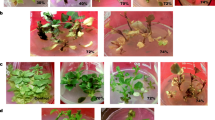Abstract
In vitro treatment of tissue cultures of two garlic cultivars with crude culture filtrates from Sclerotium cepivorium was used to select somaclonal variants with enhanced resistance to white rot disease. The crude culture filtrate had a negative effect on callus induction and growth. It also inhibited the differentiation of adventitious buds. The inhibitory effects were greater at higher culture filtrate concentration. With increase in concentration of crude pathogen culture filtrate, rate of callus induction, callus survival, relative growth rate of callus, callus differentiation and number of divided shoots per callus decreased. The inhibitory effect for all the parameters was more visible when crude pathogen culture filtrate was used at 50% concentration or more. However, the performance of disease resistant cultivar Hangzhong Red Skin was better than Gailiang (disease susceptible cultivar) at higher concentrations of crude pathogen culture filtrate. Some somaclonal lines and plantlets (predominantly from Hangzhong Red Skin) that showed resistance to Sclerotium cepivorum were obtained at 50%concentration level of crude pathogen culture filtrate.









Similar content being viewed by others
References
Carlson PS (1973) The use of protoplasts for genetic research. Proc Natl Acad Sci U.S.A. 70:598–602
Cheng ZH, Xing YJ (2005) In vitro screening of resistant potato clones to late blight with crude Phytophthora infestans toxin. Acta Bot Boreal-Occid Sin 25(12):2402–2407
Ganesan M, Jayabalan N (2006) Isolation of disease-tolerant cotton (Gossypium hirsutum L. cv. SVPR 2) plants by screening somatic embryos with fungal culture filtrate. Plant Cell Tissue Organ Cult 87:273–284
Gauri S, Praveen CV, Laiq-ur R, Suchitra B, Shuklac RS, Sushil K (2008) Selection of leaf blight-resistant Pelargonium graveolens plants regenerated from callus resistant to a culture filtrate of Alternaria alternate. Crop Prot 27:558–565
Kumar S, Sunil K, Negi SP, Kanwar JK (2008) In vitro selection and regeneration of chrysanthemum (Dendranthema grandiflorum Tzelev) plants resistant to culture filtrate of Septoria obesa Syd. In Vitro Cell Dev Biol Plant 44:474–479
Li J, Cheng ZH, Zhang GY (2004) In vitro selection of salt-tolerant mutant in potato. J Northwest Sci-Tech Univ Agric For 32(8):43–48
Liang J, Cheng ZH (2010) Research progress in garlic white rot and its control. China Veg 14:13–18
Ma H, Zhang L, Zhong M (2007) Screening mutant against false smut disease by using pathotoxin. J Anhui Agric Sci 35(16):4746–4747
Manoj KR, Rajwant KK, Rohtas S, Manu PG, Dhawana AK (2011) Developing stress tolerant plants through in vitro selection—an overview of the recent progress. Environ Exp Bot 71:89–98
Mary RM, Maria de los AJ, Marilyn HYH (2004) Management of diseases of onions and garlic. Dis Fruits Veg 2:149–200
Melero-Vara JM, Pradoes-Ligero AM, Basallote-Ureba MJ (2000) Comparison of physical, chemical and biological methods of controlling garlic white rot. Eur J Plant Pathol 106:581–588
Nabulsi I, Al-safad B, Mir AN, Arabi MIE (2001) Evaluation of some garlic (Allium sativum L.) mutants resistant to white rot disease by RAPD analysis. Ann Appl Biol 138:197–202
Perez-Moreno L, Lopez-Munoz J, Pureco A, Hinojosa JC (1991) Production of radiation induced mutants of garlic (Allium sativum L.) resistant to white rot caused by the fungus Sclerotium cepivorum Berk. Plant mutation for crop improvement. IAEA 498:211–219
Rutkowska-Krause I, Mankowska G, Lukaszewicz M, Szopa J (2003) Regeneration of flax (Linum usitatissimum L.) plants from anther culture and somatic tissue with increased resistance to Fusarium oxysporum. Plant Cell Rep 22:110–116
Savita, Gurdeep SV, Avinash N (2011) In vitro selection of calli of Citrus jambhiri Lush. for tolerance to culture filtrate of Phytophthora parasitica and their regeneration. Physiol Mol Biol Plants 17(1):41–47
Sengar S, Thind KS, Bipen K, Mittal P, Gosal SS (2009) In vitro selection at cellular level for red rot resistance in sugarcane (Saccharum sp.). Plant Growth Regul 58:201–209
Srinath R, Ramgoapl S (2010) Effect of Alternaria helianthi culture filtrate on callus and regeneration of plantlets from tolerant callus in sunflower (Helianthus annuus L.). Indian J Biotechnol 187–191
Yoder OC (1990) Toxin in pathogenesis. Ann Rev Phytopathol 18:103–129
Zhang ER, Cheng ZH (2003a) Study on in vitro selection for glyphosate-resistant callus of garlic. J Northwest Sci-Tech Univ Agri For (Nat Sci Ed) 31(3):69–72, 76
Zhang ER, Cheng ZH (2003b) Study on in vitro select ion of salt- tolerant calluses of garlic. Acta Bot Boreal -Occid Sin 23(9):1571–1576
Zhang LQ, Cheng ZH (2008) Optimization of culturing conditions for toxin production by Sclerotium cepivorum Berk. of garlic. Acta Hortic Sin 35(6):841–846
Zhang GF, Zhang Y (2004) Control technology of garlic white rot. J Changjiang Veg 2:31
Zhang XC, Lutova LA, Han ZH (2000) Study on the selection of tomato resistant mutant line to Phytothphora infestans (Mont.) De Bary by cellular breeding. Acta Hortic Sin 27(5):377–379
Zhang ER, Cheng ZH, Zhou XM (2004) Study on chromosomal variation of somatic clones of garlic. J Northwest Sci-Tech Univ Agric For 32(9):73–76
Zhao MM, Liu ZP, Hui XW (2006) Research on in vitro screening of resistant mutants of eggplant to Verticillum daliae with fungi toxin. Acta Agric Boreal-Sin 21(01):92–95
Acknowledgements
This research was funded by the project of National Commonweal (Agriculture) Scientific Research (200903018–7) and National Key Technologies R&D Program of China during the 11th five-year plan period (2006BAD07B02) .
Author information
Authors and Affiliations
Corresponding author
Rights and permissions
About this article
Cite this article
Zhang, Lq., Cheng, Zh., Khan, M.A. et al. In vitro selection of resistant mutant garlic lines by using crude pathogen culture filtrate of Sclerotium cepivorum . Australasian Plant Pathol. 41, 211–217 (2012). https://doi.org/10.1007/s13313-011-0109-z
Received:
Accepted:
Published:
Issue Date:
DOI: https://doi.org/10.1007/s13313-011-0109-z




